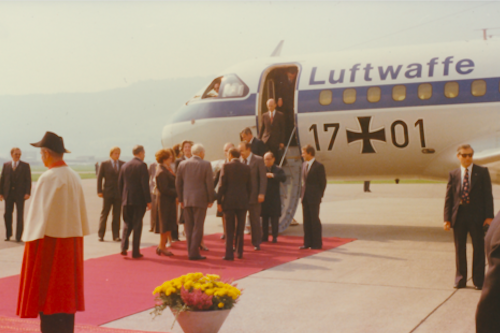«German Autumn» in Switzerland
The first priority of the Germans was the demonstration of normality. For when President Walter Scheel was on a state visit in Bern in autumn 1977, the Federal Republic was suffering its worst crisis since the end of the war. The «Red Army Faction» (RAF) had started their «Offensive 77»: by kidnapping the president of the German Employers' Associations Hanns Martin Schleyer on 5 September 1977, the terrorists sought to make demands for the release of the RAF-Leadership which was imprisoned in Stammheim. This marked the beginning of the terrifying and death-filled «German Autumn».
Armored Vehicle Patrols und Barricades
Even though the West German government was «credibly trying to do ‹business as usual›», it nonetheless meant that «daily life has increasingly been interrupted by police security measures (armored vehicle patrols, barricading of public buildings and domiciles of political persons[...])», wrote the Swiss ambassador in Bonn prior to the state visit. «These have been intensified in recent days due to the imminent danger of further abductions» (dodis.ch/50277). When Scheel stayed with Foreign Minister Hans-Dietrich Genscher in Bern between 22 and 24 September, it was deemed necessary to introduce «by Swiss standards unusual safety measures for the protection of the German state guests» (dodis.ch/50265).
Battle against the «Demons of Denial»
President of the Confederation Kurt Furgler expressed in his opening speech Switzerland's solidarity with its neighbor, its «sadness and outrage at the heinous murder of innocents» and its «heartfelt sympathy» with the family of the kidnapped hostage. The battle against the «Demons of Denial» must be «won with the weapons of the constitutional state» as Furgler and the West German guests were agreed upon (dodis.ch/50280). In the press the «contempt for mankind», «which the terrorists of 1977 have also dedicated themselves to» was seen as rooted in the national socialist policy of extermination. Frank A. Meier of the «Basler Zeitung» wrote with certainty that Switzerland, which had no similarly burdened past, «was not by sheer chance not a country of terrorists». With its democratic traditions it would be sufficiently protected «from political perversions» (dodis.ch/50265).
RAF-Terror in Switzterland?
In reality the Swiss authorities were also preparing for the growing terrorist threat. The Federal Council endeavored through international collaboration (dodis.ch/50253) as well as as a tightening of national law (dodis.ch/50254), e.g. in the realm of the law concerning war material (dodis.ch/50293), to implement defensive measures. The Attorney General's office informed the federal administration with guidelines on how to best defend oneself against attacks (dodis.ch/50279). «Fundamentals of Self Defense» conveyed strategies against being kidnapped: «Should someone try to force your car to the side» was written in the «Small Guide for Senior Staff», «accelerate immediately, even at risk of causing an accident» (dodis.ch/50278).
The Case of Petra Krause
The cause of much talk in the autumn of 1977 was the case of RAF-member Petra Krause, who had been under arrest in Zurich for almost three years. The German-Italian dual citizen was accused of participating in bombings in Switzerland as well as having stolen mines and hand grenades from army depots with Zurichois anarchists and having delivered these to the RAF and the «Brigate Rosse». The slowness of the court proceedings combined with solitary confinement, against which Krause protested with hunger strikes, displayed the penal and judicial system of Zurich in a bad light. In Italy left members of parliament and media launched a campaign in August 1977 against the «fascist» imprisonment conditions and the «violations of human rights» in the case of Krause (dodis.ch/50026). Swiss-Italian relations were heavily strained by the affair (dodis.ch/50239).
Airplane Hijackings of Entebbe...
The case of Krause had already kept the Federal Council busy in the summer of 1976. When Palestinian terrorists hijacked a French commercial aircraft to Entebbe in Uganda, they demanded the release of a total of 53 prisoners in Israel, West Germany, Kenya and France as well as the RAF-terrorist in Switzerland. The special staff in Bern were therefore on their toes the night of 4 July 1976, when Israeli special forces managed a spectacular raid to free and secure the hostages (dodis.ch/50247). The Palestinian terror had already been a serious challenge for Switzerland since the Kloten attack 1969 (cf. dodis.ch/T1390), the tragedy of Würenlingen (cf. dodis.ch/T1389) and the airplane hijackings to Zarqa 1970 (cf. dodis.ch/T1391).
... and Mogadishu
The «German Autumn» ended with another act of aircraft hijacking by the Popular Front for the Liberation of Palestine (PFLP), which wanted to support the RAF in their struggle. On 13 October a Genevan lawyer who acted as the speaker of the Palestinian terrorists announced that the PFLP had abducted the Lufthansa-Machine «Landshut» to Somalia (dodis.ch/50251). In Mogadishu a West German special unit managed to overpower the terrorists in the stolen airplane (dodis.ch/50252).
«Terrorism is not a German invention»
Few months after the «days of horror» had ended bloodily with the «night of death in Stammheim» and the murder of Schleyer, the Swiss ambassador in Bonn observed a friendlier climate once more. New acts of terror remained absent for the time being and the «initially feared hysterical cry for order had abated» (dodis.ch/50282). Switzerland remained mostly spared by the RAF-terror. Nonetheless many felt its traces in Switzerland. The «Solothurner Zeitung» definitely did not share the «somewhat self-righteous opinion» of Frank A. Meyer which had been presented on the occasion of Scheel's state visit: «International Terrorism is not a German invention and does not stop at the German-Swiss border» (dodis.ch/50265).
